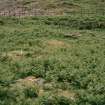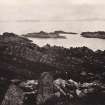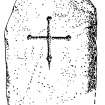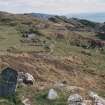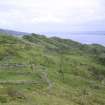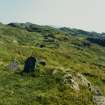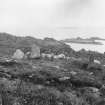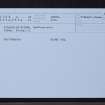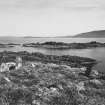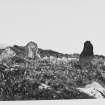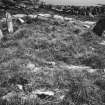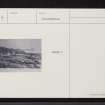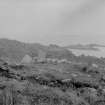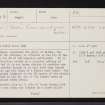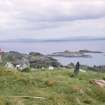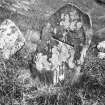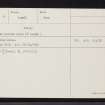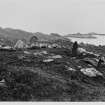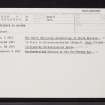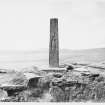Garvellachs, Eileach An Naoimh
Cross Incised Stone (Early Medieval), Enclosure (Early Medieval), Grave (Early Medieval)
Site Name Garvellachs, Eileach An Naoimh
Classification Cross Incised Stone (Early Medieval), Enclosure (Early Medieval), Grave (Early Medieval)
Alternative Name(s) Eithne's Grave; Ethnie's Grave
Canmore ID 22364
Site Number NM60NW 4
NGR NM 63927 09646
Datum OSGB36 - NGR
Permalink http://canmore.org.uk/site/22364
- Council Argyll And Bute
- Parish Jura
- Former Region Strathclyde
- Former District Argyll And Bute
- Former County Argyll
NM60NW 4 6394 0964.
(NM 6394 0964) Grave (NR)
OS 6" map (1900)
An enclosure, reputedly the grave of Eithne, the mother of St Columba, is situated on the top of the ridge to the SW of the monastic settlement. It is 11' in diameter, marked by a circular setting of stones, but is it not known whether it contains one or more graves; though it is said that when opened many years ago the bones of a female were found. Two small upright slabs are in the NE sector of the circle, and another in the SW, one of the former bears an early incised Greek cross.
Muir describes site as "a pile of loose stones laid together like altar and flanked by a short pillar bearing an incised cross (? leacht).
T H Bryce and G A F Knight 1930
As described above.
Visited by OS (AC) 8 April 1970
(1) On Eithne's Grave, a circular 'special grave' overlooking the site (NM60NW 4), is a gravemarker, 0.71m by 0.4m, bearing an incised equal-armed cross with pitted terminals and a short spike below the base.
I Fisher 2001.
Measured Survey (1974)
RCAHMS produced a plan of Eithne's Grave in 1974, and a detailed drawing of the cross-incised stone c.1982. The plan was redrawn in ink and published at a reduced scale (RCAHMS 1984, fig. 176A) while the stone was illustrated at 1:15 (fig. 181A).
Field Visit (May 1981)
Eithnie's Grave. This small circular enclosure, identified in 19th-century local tradition as the burial-place of St Columba's mother, (Bryce and Knight 1933; Muir 1861; Ordnance Survey Name Book) is situated 130m SW of the inner enclosure (RCAHMS 1985, A on plan), at an elevation of about 35m OD. It is placed at the edge of a scarp from which the hillside slopes steeply to SSE and ENE, and although visible from the inner enclosure, it is most conspicuous from the boat-landing and approach. It comprises a kerb of flattish slabs, about 0.8m in average thickness, enclosing a roughly circular area about 3.2m in diameter. Investigation of the kerb by the Inspectorate of Ancient Monuments in 1972 showed that the structure lies on sloping bedrock, being built up on the SE or downhill side to a height of about 1m, whereas to the N and W it is almost level with the ground-surface. (information from Mr S H Cruden) The soil within the kerb, which was not excavated in 1972, was presumably imported to allow burials. At the NE edge of the enclosure are two upright slabs, side by side and 0.35m apart. That to the SE is incised with a cross on the SW face (infra, number 1), and facing it at a distance of 2.6m is a third upright slab, of slate. Reports of the discovery of female remains in this area are extremely vague (Bryce and Knight 1933) and it is not known whether the enclosure contained more than one grave. It appears to belong to a class of 'specially marked graves', which are found in Western Britain and Ireland in the Iron Age and Early Christian period.(the plan of Eithne's Grave in Thomas 1971 is incorrect in suggesting the survival of four upright slabs, and in showing the position of a grave)
Funerary Monument
Roughly rectangular slab with rounded top, of local flaggy sandstone. It measures 0.71m in visible height by 0.40m in width. On the SW face is incised an equal-armed cross whose arms terminate in small circular expansions. The line of the lower arm is continued for 40mm below the terminal by a less deeply-cut groove. (Anderson, J, Scotland in Early Christian times, 1st series (1881), fig. 34 on p.96, reproduced in ECMS, 3, fig. 421; TGAS, new series, 8 (1925-33), figs. 19a, 22).
Visited May 1981
RCAHMS 1984



























